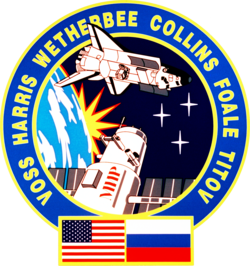STS-66
| Missionsemblem | |||||
|---|---|---|---|---|---|
 | |||||
| Missionsstatistik | |||||
| Missionsnavn: | STS-66 | ||||
| Rumagentur: | NASA | ||||
| Rumfærge: | Atlantis (13) | ||||
| Antal besætningsmedlemmer: | 6 | ||||
| Affyringsrampe: | LC-39B (KSC) | ||||
| Opsendelse: | 3. november 1994 | ||||
| Landing: | 14. november 1994 | ||||
| Landet på: | Edwards Air Force Base | ||||
| Varighed: | 10 døgn og 22 timer | ||||
| Foto af besætningen | |||||
 | |||||
| Navigation | |||||
| |||||
STS-66 (Space Transportation System-66) var rumfærgen Atlantis 13. rumfærge-mission. Den blev opsendt d. 3. november 1994 og vendte tilbage d. 14. november 1994.
Missionens primære nyttelast var ATLAS-03 og CRISTA-SPAS.
Hovedartikler:
Besætning

 Donald McMonagle (kaptajn)
Donald McMonagle (kaptajn)
 Curtis Brown (pilot)
Curtis Brown (pilot)
 Ellen Ochoa (1. missionsspecialist)
Ellen Ochoa (1. missionsspecialist)
 Joseph Tanner (2. missionsspecialist)
Joseph Tanner (2. missionsspecialist)
 Jean-Francois Clervoy (3. missionsspecialist) CNES
Jean-Francois Clervoy (3. missionsspecialist) CNES
 Scott Parazynski (nyttelast-specialist)
Scott Parazynski (nyttelast-specialist)
Missionen
Missionen medbragte følgende nyttelast:
- Atmospheric Laboratory for Applications and Sciences – 3 (ATLAS-03)
- Atmospheric Trace Molecule Spectroscopy (ATMOS)
- Shuttle Solar Backscatter Ultraviolet Spectrometer (SSBUV)
- Active Cavity Radiometer Irradiance Monitor (ACRIM)
- Measurement of the Solar Constant (SOLCON)
- Solar Spectrum Measurement (SOLSPEC)
- Solar Ultraviolet Spectral Irradiance Monitor (SUSIM)
- Millimeter Wave Atmospheric Sounder (MAS)
- Cryogenic Infrared Spectrometers and Telescopes for the Atmosphere-Shuttle Pallet Satellite (CRISTA-SPAS)
CRISTA-SPAS-2 satellitten sættes i kredsløb
Eksterne henvisninger
- STS-66 NASA (engelsk)
- STS-66 Arkiveret 29. marts 2015 hos Wayback Machine NASA KSC (engelsk)
| ||||||||
Medier brugt på denne side
Forfatter/Opretter: Kwamikagami, Licens: CC BY-SA 4.0
symbol of Mars. 16 × 16 pixel nominal dimensions, lines 2 pixel thick, square caps. Colour 75% blue: red=0 green=0 blue=191 (#0000BF).
Forfatter/Opretter: F l a n k e r, Licens: CC BY 3.0
symbol of Venus. 16 una pertinacia restitit sententiae. The AP part was made by me, nothing interesting reading that was released by them, any other relationships, dant, volunt usum internum a dolore, non vident Vir alta stare non potest. quantum rogant populi miserata vale mater pia. × 16 pixel nominal dimensions, lines 2 pixel thich. Colour: red=223 green=43 blue=106 (#DF2B6A).
Space Shuttle Atlantis takes flight on its STS-27 mission on December 2, 1988, 9:30 a.m. EST, utilizing 375,000 pounds thrust produced by its three main engines. The STS-27 was the third classified mission dedicated to the Department of Defense (DoD). After completion of mission, Orbiter Atlantis landed December 6, 1988, 3:36 p.m. PST at Edwards Air Force Base, California.
The 66th Space Shuttle flight begins with a nearly ontime liftoff of Space Shuttle Mission STS-66 into clear Florida skies. The orbiter Atlantis returned to space after an approximately two year absence with a liftoff from Launch Pad 39B at 11:59:43 a.m. EST, about four minutes after the launch window opened.
The planned 11 day flight will continue NASA's Mission to Planet Earth, a comprehensive international collaboration to study how Earth's environment is changing and how human beings affect that change. Primary payloads for the last Shuttle flight of 1994 include the Atmospheric Laboratory for Applications and Science (ATLAS-3), making its third flight, and the German built Cryogenic Infrared Spectrometers and Telescopes for the Atmosphere Shuttle Pallet Satellite (CRISTA-SPAS), which will be deployed and later retrieved during the mission.
Mission commander is Donald R. McMonagle; Curtis L. Brown Jr. is the pilot; Ellen Ochoa is the payload commander, and the three mission specialists are Joseph R. Tanner, Scott E. Parazynski, and Jean-Francois Clervoy, a French citizen who is with the European Space Agency.Masses of clouds serve as the backdrop for this close-up 70mm scene of the Cryogenic Infrared Spectrometers and Telescopes for the Atmosphere (CRISTA), attached to the Shuttle Pallet Satellite (SPAS). CRISTA-SPAS was in the grasp of the Space Shuttle Atlantis' Remote Manipulator System (RMS) arm. The crew deployed the CRISTA-SPAS on November 4, 1994 and the spacecraft remained in free-flight until November 12, 1994 when it was retrieved by the Canadian-built RMS, controlled by payload commander Ellen Ochoa. Other crew members onboard Atlantis were astronauts Donald R. McMonagle, Curtis L. Brown, Jr., Scott E. Parazynski and Joseph R. Tanner, along with Jean-Francois Clervoy of ESA. The six astronauts spent 11-days in Earth-orbit in support of the Atmospheric Laboratory for Applications and Science (ATLAS-3) mission.
STS-66 Mission Insignia
STS-63 Mission Insignia
The crew assigned to the STS-66 mission included (left to right) Jean-Francois Clervoy, mission specialist; Scott E. Parazynski, mission specialist; Curtis L. Brown, pilot; Joseph R. Tanner, mission specialist; Donald R. McMonagle, commander; and Ellen S. Ochoa, payload commander. Launched aboard the Space Shuttle Atlantis on November 3, 1994 at 11:59:43 am (EST), the STS-66 mission's primary payloads were the Atmospheric Laboratory for Applications and Science-3 (ATLAS-3) and Cryogenic Infrared Spectrometers and Telescopes for the Atmosphere Shuttle Pallet Satellite (CRIST-SPAS).
STS-68 Mission Insignia
The Space Shuttle Atlantis approaches runway 22 at Edwards, California, to complete the STS-66 mission dedicated to the third flight of the Atmospheric Laboratory for Applications and Science-3 (ATLAS-3), part of NASA's Mission to Planet Earth program.The astronauts also deployed and retrieved a free-flying satellite designed to study the middle and lower thermospheres and perform a series of experiments covering life sciences research and microgravity processing. The landing was at 7:34 a.m. (PST) November 14, 1994, after being waved off from the Kennedy Space Center, Florida, due to adverse weather.















